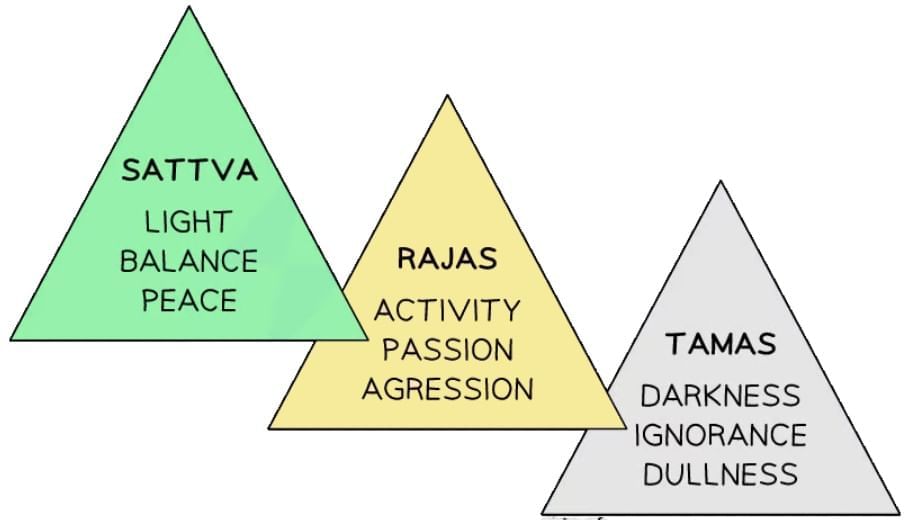Matter | Religion, Philosophy & Ethics for GCSE/IGCSE - Year 11 PDF Download
| Table of contents |

|
| What is Matter? |

|
| The Three Qualities |

|
| 3-Qualities |

|
| Illusion |

|
| Cosmology |

|
What is Matter?
Hindus recognize two fundamental realities: spirit (purusa) and matter (prakriti).
- Spirit refers to entities that cannot be perceived through sight or touch.
- Matter encompasses tangible elements within the universe that can be seen and interacted with physically.
Hindus hold diverse perspectives on the interplay between spirit and matter, generally prioritizing spirit over matter due to the latter's impermanence. Matter is considered destructible, while spirit is eternal.
- The transient nature of the material world encourages Hindus to detach from material possessions.
- Upon achieving enlightenment, the material world is perceived as an illusion (maya), losing its substantiality.
- Maya acts as a veil, obscuring the true nature of reality and preventing individuals from perceiving the ultimate truth.
The Hindu spiritual journey emphasizes attaining enlightenment to transcend concerns with temporary, material things and focus on eternal truths.
The Three Qualities
Hindus believe that all matter undergoes a cyclical process of creation, existence, and destruction, which aligns with the roles of the Trimurti: Brahma (the creator), Vishnu (the preserver), and Shiva (the destroyer).
This cycle is reflected in the Tri-guna, the three qualities that characterize all matter:
- Sattva: Represents harmony and goodness, a state of balance and purity.
- Rajas: Embodies energy, action, change, and movement, often associated with passion.
- Tamas: Signifies darkness and ignorance, reflecting inertia or lack of awareness.

3-Qualities
The term gunas translates to "qualities," and these qualities permeate every aspect of maya (the illusory material world).
- The gunas manifest in natural phenomena such as the cycles of day, seasons, and even in food, thoughts, and actions.
- In human life, they are expressed as passion (rajas), goodness (sattva), and ignorance (tamas), shaping individual behavior.
- Every entity, whether living or non-living, embodies these three qualities to varying degrees.
- An individual’s behavior is influenced by which guna is most dominant at any given time, affecting their thoughts, actions, habits, and overall character.
- The concept of prakriti is significant because the soul’s inclination toward goodness, passion, or ignorance influences its reincarnation in the cycle of samsara.
- To achieve moksha (liberation from the cycle of reincarnation), individuals must be mindful of the gunas and strive for spiritual growth.
Illusion
The Distraction of Maya
Hindus view all material existence as an illusion, referred to as maya, which distracts individuals from perceiving spiritual truth.
- Maya represents the self-centered tendencies and attachments that cloud one’s understanding of reality.
- It exerts a powerful influence, leading people to prioritize relationships, family, and possessions over spiritual truth.
- Hindu teachings suggest that attachment to material things—such as one’s body, home, property, children, relatives, or wealth—deepens the illusion of “I and mine,” reinforcing maya’s hold (Bhagavata Purana 5.5.8).
The Aim of Hinduism
The ultimate goal in Hinduism is to seek reunion with Brahman, the divine ultimate reality, rather than being consumed by material attachments.
Hindu scriptures provide guidance on overcoming maya through spiritual discipline and practice:
Bhagavad Gita 2.60–3: “The senses are so strong … they can forcibly carry away the mind even of a person endowed with discrimination and practising self-control. They are established in perfect knowledge, who subdue their senses and keep their minds ever absorbed in me. While contemplating on the objects of the senses, one develops attachment to them.”
This teaches that the senses (e.g., sight and hearing) can distract the mind, requiring self-control to focus on the divine rather than material objects.
Bhagavad Gita 2.60–3: “Attachment leads to desire, and from desire arises anger. Anger leads to clouding of judgement, which results in bewilderment of the memory. When the memory is bewildered, the intellect gets destroyed; and when the intellect is destroyed, one is ruined.”
This explains how attachment to illusory material desires leads to a chain reaction of anger, clouded judgment, and spiritual ruin.
Cosmology
Hindu Cosmology
Hindu cosmology explores the nature and functioning of the universe through a variety of interconnected narratives.
- The universe is often depicted as an infinite egg, called Brahmanda, forged by Brahman.
- The material world is not considered the ultimate reality; instead, a greater spiritual reality transcends what can be seen, heard, or touched.
- Time in Hinduism is cyclical, with the material world undergoing repeated creation, preservation, and destruction, known as the cosmic cycle or cycle of samsara.
- The cosmos is envisioned as one of many bubbles floating in space, comprising three tiers:
- The heavenly planets.
- The earthly realm.
- The lower worlds.
Cosmology and Hindu Beliefs and Practice
Hindu cosmology emphasizes dharma (duties) toward creation, forming the foundation for moral and ethical conduct as prescribed in Hindu scriptures.
- Karma operates on the principle of cause and effect, where every action, thought, or deed has consequences that may manifest in this life or future lifetimes.
- The ultimate aim is moksha, liberation from the cycle of samsara, achieved through realizing one’s unity with Brahman, marking the end of individual existence and reunion with the divine.
- Understanding cosmology fosters awareness of the transient nature of the material world, guiding individuals toward spiritual practices that lead to moksha.
|
172 docs|3 tests
|
FAQs on Matter - Religion, Philosophy & Ethics for GCSE/IGCSE - Year 11
| 1. What is the concept of matter in Hindu philosophy? |  |
| 2. What are the three qualities (Gunas) associated with matter in Hinduism? |  |
| 3. How does the concept of Maya relate to Hindu beliefs? |  |
| 4. What is the aim of Hinduism in relation to cosmology? |  |
| 5. How do Hindu cosmological beliefs influence daily practices and rituals? |  |














